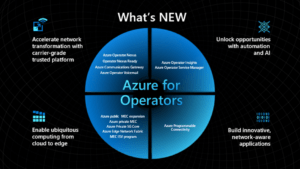Over the past decade, we at Microsoft have seen a tremendous amount of change—digital transformation enabled by the cloud. But the cloud’s biggest impact is yet to come. McKinsey estimates that by 2030, we’ll see more than a trillion dollars impacted by the cloud across the Fortune 500.1 In an industry currently experiencing large-scale transformation, this represents a huge opportunity.
The future cloud, however, will look very different from the cloud of today. It will expand to become a highly distributed fabric, spanning 5G to space. It will be powered by a modern network infrastructure and will enable a new application and connectivity paradigm—what we call modern connected apps—that puts compute even closer to the problems we need to solve.
This new generation of highly distributed, low latency, and network-aware applications uses 5G innovation to enable computing where it’s needed most and opens entirely new scenarios for operators, enterprises, and developers across a range of industries.
Unlocking the opportunity for the telecommunications ecosystem
At Microsoft, our aim is to be the most trusted co-innovation partner through every stage of the digital evolution, committed to working with communications service providers (CSPs), enterprises, developers, and ISVs alike on the future of a ubiquitous cloud that unlocks the true potential of modern connected apps.
We are empowering operators to accelerate their network transformation with our carrier-grade, trusted platform and helping them unlock new opportunities with automation and AI.
We are enabling enterprises with ubiquitous computing that spans from cloud to edge.
And we are helping developers and ISVs build more innovative, network-aware applications.
Microsoft is providing the key solutions that are shaping the future cloud, and we have some exciting news in each of these areas to help operators, enterprises, and developers get started.

Accelerate network transformation with carrier-grade trusted platform
One of our goals is to enable operators to optimize their existing investments and services and to accelerate network transformation on our carrier-grade, trusted hybrid platform. Central to this goal is our Azure for Operators portfolio.
Last year, we unveiled a new wave of Azure for Operators solutions and services, which continue to enable the secure development of high-performance, low-latency applications, and next-generation wireless solutions.
Introducing Microsoft Azure Operator Nexus
Today we are announcing the public preview of Azure Operator Nexus—the next-generation hybrid cloud platform created for communications service providers (CSPs). Since we debuted the private preview at MWC 2022, we’ve expanded the capabilities of Operator Nexus to meet the needs of operators that are looking to modernize and transform their network. Operator Nexus enables operators to use cloud technology to modernize and monetize their network investments—lowering total cost of ownership (TCO), driving operational efficiency and resiliency with advanced AI and automation, improving the security of highly distributed, software-based networks.
Operator Nexus enables operators to run their workloads on-premises or on Azure, where they can seamlessly deploy, manage, secure, and monitor everything—from the bare metal to the network to the tenant. It is purpose-built for carrier-grade workloads, using the same Azure experience offered by the hyperscale public cloud, supporting our first-party solutions as well as a wide variety of our partner ecosystem offerings from industry-leading network equipment provider (NEP) partners. Proven to run network functions at a tier-one operator scale, Operator Nexus meets the security, resiliency, observability, manageability, and performance needs required by operators to achieve meaningful business results throughout the digital transformation of their mobile network.
“As a pioneer in network virtualization and SDN, AT&T is confident in our decision to run our multi-vendor 5G Standalone Mobile Core on Operator Nexus platform while we continue to deploy and operate the platform in AT&T data centers. AT&T made the decision to adopt Operator Nexus platform over time with expectation to lower total cost of ownership (TCO), leverage the power of AI to simplify operations, improve time to market, and focus on our core competency of building the world’s best 5G service. We appreciate the efforts of our Network Function ecosystem collaborators to support the evolution of our Mobility Core platform.”—Igal Elbaz, Senior Vice President, Network CTO, AT&T
“Through the combination of Ericsson’s market-leading, cloud-native 5G Core applications and orchestration suite with Microsoft’s carrier-grade Operator Nexus platform, we envision many opportunities for CSPs to digitally transform their core networks while improving customer experiences and creating exciting, new mobile services. Building on our success at mutual customers such as AT&T, Ericsson, and Microsoft are investing together to ensure Ericsson 5G Core cloud-native applications run on the Operator Nexus platform efficiently, securely, and reliably.”—Monica Zethzon, Vice President and Head of Solution Area Core Networks, Ericsson
“With the addition of Mavenir’s open cloud-native architecture end-to-end solutions including Converged Packet Core to Operator Nexus platform we look forward to working with Microsoft to help operators drive their core network transformations.”—Bejoy Pankajakshan, EVP, Chief Technology and Strategy Officer, Mavenir
“We’re excited to further strengthen our growing partnership with Microsoft to Nokia’s Cloud and Network Services portfolio that enables operators to run Nokia’s cloud-native 5G Core on Operator Nexus’ carrier-grade hybrid cloud platform as well as for Nokia to provide the network functions and platform to make operator network APIs available to developers through the Azure platform.”—Fran Heeran, SVP, Core Networks, Nokia Cloud and Network Services, Nokia
Learn more about Operator Nexus in this Operator Nexus blog and this Operator Nexus video.
Azure Operator Nexus Ready and systems integrator programs
We are also introducing the Operator Nexus Ready and systems integrator (SI) programs to ensure that our platform has a broad and trusted ecosystem of support. To accelerate deployment and integration, the Operator Nexus Ready program certifies that the ecosystem of cloud-native network functions (CNFs), virtual network functions (VNFs), and other software interoperate with the Operator Nexus platform. We are in the process of certifying VNFs and CNFs from a range of partners with two certification levels.
Level one is a base level that assures interoperability with the Operator Nexus platform.
Level two adds Azure deployment automation using the Azure Network Function Manager and offers entrance into the Azure Marketplace for ready availability to operators.
Additionally, our Operator Nexus SI program includes a select group of systems integrators known for both their telecommunications expertise, as well as their broad Azure skills. Each of these partners will work closely with the Operator Nexus engineering team to build their Operator Nexus platform skills, and to assure customer success in deployment and integration.
Voice Core reimagined
Another crucial aim of ours is to help optimize operators’ existing communications investments and services. To this end, we are announcing the general availability of Azure Communications Gateway and the private preview of Azure Operator Voicemail. We developed these voice services to support fixed and mobile operators as they continue to migrate critical voice workloads to the cloud.
Azure Communications Gateway provides operators with the critical interworking functionality required to connect an operator’s established public switched telephone network (PSTN) directly to Microsoft Teams, enabling them to deliver Operator Connect and Teams Phone Mobile services. Communications Gateway is a globally available, managed service that offers an alternative to on-premises solutions for session initiation protocol (SIP) interworking and API automation, thereby simplifying network integration and expediting operators’ time to market. To learn more, read the Azure Communications Gateway Tech Community blog.
Azure Operator Voicemail enables operators to migrate their voicemail services to Azure and take advantage of a fully managed service, reducing the operational support burden and allowing for greater focus on revenue-producing projects. To learn more, read the Azure Operator Voicemail Tech Community blog.
With these announcements, we remain committed in our effort to accelerate network transformation and meet operators exactly where they are on their cloud journey.
Unlock opportunities with automation and AI
The world has been inspired by the transformative power of AI thanks to the recent success of ChatGPT and our ongoing partnership with OpenAI. Now, operators can take advantage of specialized, advanced AI solutions that help to unlock new business opportunities from data and insights in their operations, such as AIOps.
Next-gen AI operations for operators
The complexity of managing 5G services requires a new way of managing networks dependent on real-time analysis of massive quantities of data that applies predictive AI to inform the configuration of the product environments. AIOps employs the same operational techniques and capabilities that Microsoft uses to manage Azure, one of the world’s most complex services, packaged specifically for operators’ needs.
Today, we are announcing the public preview of two AIOps services Azure Operator Insights and Azure Operator Service Manager. These hybrid services simplify the management of existing networks as well as ensure new Microsoft services, such as Azure Operator Nexus, Voice Communications Gateway, and Operator 5G Core, are managed with consistent approaches for monitoring, diagnostics, and lifecycle management.
Azure Operator Insights enables the collection and analysis of massive quantities of network data gathered from complex multi-part or multi-vendor network functions. It delivers insights for operator-specific workloads to help operators understand the health of their networks and the quality of their subscribers’ experiences.
Azure Operator Service Manager provides seamless management of complex services deployed across hybrid cloud sites. Combined with consolidated management across Azure cloud and edge platforms, Operator Service Manager helps to accelerate operator service deployment. Together, these new services generate insights from data to inform the configuration of the network—with changes tested thoroughly using Safe Deployment Processes. We are making them available to operators, NEPs, and SIs directly for managing workloads in operators’ networks, Azure, and hybrid environments. We look forward to the opportunities these new AIOps services bring operators in the future.
“3UK is laser-focused on delivering world-class gaming experience to mobile users and we are excited to be working with the Microsoft Azure for Operators organization whose new operator-specific analytics services are delivering near real-time insights with quality, timeliness, and cost-effectiveness not otherwise possible.”—Iain Milligan, Chief Network Officer, 3UK
“2degrees delivers world-class mobile services to our customers. We are excited to be working with Microsoft Azure for Operators and their new operator-specific analytics services. Together we are exploring innovative capabilities using the new Azure Operator Insights analytics service, focusing on ensuring we continue to provide our customers with the exceptional mobile services they expect.”—Saul Parkinson, Core Network Architect, 2degrees
Azure for Operators brings together a truly better-together portfolio that encompasses many aspects of the operator’s network. It’s rooted in Azure Operator 5G Core and deployed by Azure Operator Service Manager on Azure Operator Nexus. Using AI from Azure Operator Insights, it’s intelligently operated and monitored. And importantly, it includes opportunities for our ecosystem of partners. Watch the video to learn more about how we are empowering operators to modernize and monetize their 5G investments.
Build innovative, network-aware applications with new Azure Programmable Connectivity
Along with operators, we are also working hard to enable developers for the evolution of cloud and edge. Today, we are announcing the private preview of Azure Programmable Connectivity, a solution for developers to build network-aware modern connected applications. Azure Programmable Connectivity provides a unified, standard interface across operator networks, enabling developers to create cloud and edge-native applications that interact with the intelligence of networks. This solution will deliver a consistent, transparent experience across multiple connectivity environments such as public and private LTE/5G networks, as well as wired and satellite networks. By exposing aspects of the underlying network to applications, Azure Programmable Connectivity provides a large developers ecosystem enabling operators to monetize their infrastructure investments.
Azure Programmable Connectivity helps application developers deliver the best user experience for highly distributed, modern connected applications by offering a seamless and enriched connection between networks and diverse compute targets, such as cloud regions, private and public MEC, IoT edge, and satellite for example, ensuring that developers can access the underlying network capabilities with ease. We are also collaborating with a growing ecosystem of operators, network technology companies, and API platform providers to help unlock the potential of Azure Programmable Connectivity. These include a global operator ecosystem including AT&T, Rogers, and T-Mobile in North America; Deutsche Telekom and Telefonica in Europe; and Singtel in Asia. Microsoft is also working with network technology partners and API platform providers Ericsson including its Vonage/Ericsson Global Network Platform and Nokia including its Network as Code platform, with more partners coming soon.
As the cloud continues to grow in capability, agility, and reach, so does our platform, which enables ubiquitous computing and connectivity extending from cloud to edge—including private MEC, public MEC, on-premises, cloud regions, and even space.




